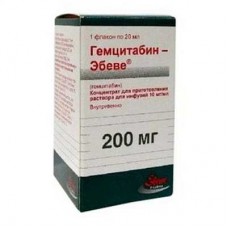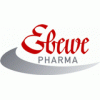Expiration date: 01/2026
Pharmacological action
Antitumor agent. It has a cytostatic effect, which is associated with inhibition of DNA synthesis. The cell is metabolized to active diphosphate and triphosphate nucleosides. Diphosphate nucleosides inhibit the action of ribonucleotide reductase, with the participation of which deoxynucleoside triphosphates are formed in the cell, necessary for the synthesis of DNA, which leads to a decrease in their concentration in the cell. Triphosphate nucleosides actively compete for inclusion in the DNA chain, and can also be included in RNA. After incorporation of intracellular metabolites of gemcitabine into the DNA chain, one additional nucleotide is added to its growing chains, which leads to complete inhibition of further DNA synthesis and programmed cell death.
Indications
Non-small cell lung cancer (stage IIIA-IV); late pancreatic carcinomas.
Contraindications
Hypersensitivity to gemcitabine.
Use during pregnancy and breast-feeding
The safety of gemcitabine during pregnancy in humans has not been studied.
In experimental studies have shown that gemcitabine has an embryonic and fetotoxic effect, adversely affects the course of pregnancy and postnatal development.
Avoid the use of gemcitabine during pregnancy. Women of childbearing age during treatment should use reliable methods of contraception.
If necessary, use during lactation should decide on the termination of breastfeeding.
Special instruction
It has some activity in the late stages of breast cancer, ovarian cancer, kidney, bladder and prostate cancer, small cell lung cancer.
Use with caution in disorders of hematopoiesis, disorders of the liver and/or kidneys. During treatment should regularly monitor the picture of peripheral blood. With the development of toxic hematological effect requires correction of dosing regimen depending on the degree of leukopenia and thrombocytopenia.
The safety and efficacy of gemcitabine in children has not been studied.
Impact on the ability to drive and operate machinery
During treatment should refrain from potentially dangerous activities that require increased attention and speed of psychomotor reactions.
Composition
1 ml contains: gemcitabine 10 mg
Dosage and administration
Set individually, depending on the indications and stage of the disease, the state of the hematopoietic system, anticancer therapy schemes.
Side effect
From the hematopoietic system: leukopenia, thrombocytopenia, anemia.
From the digestive system: nausea, vomiting, diarrhea; rarely - constipation.
From the urinary system: proteinuria, hematuria; rarely - peripheral edema; in isolated cases - renal failure.
Dermatological reactions: skin rash, itching, alopecia, stomatitis; rarely - peeling, vesicular rash, eczema.
On the part of laboratory parameters: transient increase in liver transaminases, schf, increasing the concentration of bilirubin in plasma.
From the respiratory system: rarely-bronchospasm, shortness of breath.
From the Central and peripheral nervous system: rarely-drowsiness, weakness, paresthesia.
From the cardiovascular system: rarely-hypotension, pulmonary edema; in isolated cases-myocardial infarction, arrhythmia.
Other: flu-like syndrome.
Drug interaction
The risk and severity of leukopenia and thrombocytopenia increases after previous therapy with cytostatics.




